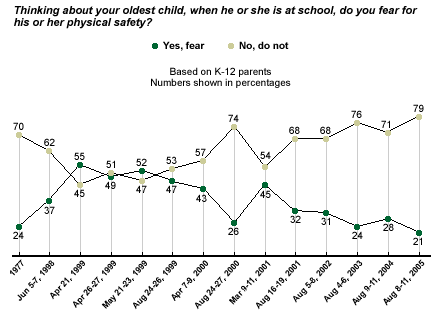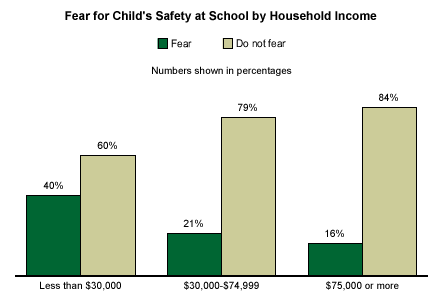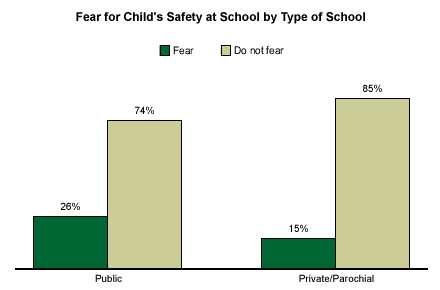Armed security guards and metal detectors greeted Red Lake (Minn.) High School students at the start of this school year. The safety measures were put in place after a student shot and killed five classmates, a security guard, a teacher, and himself last spring. That is one extreme example of the dangers children face while at school, but dangers also exist in the forms of guns and knives in student lockers and the normal bullying that is common in most school settings.
Gallup regularly asks parents of school-aged children how much they fear for their oldest child's safety when they are at school*. In the last three years, the percentage of parents with children in kindergarten through grade 12 who say they fear for that child's safety at school has ranged between 21% and 28%, with the vast majority of parents not expressing fear. That is a significant decline from the 55% of parents who expressed fear in April 1999, immediately after the Columbine High School shootings took place. In fact, the current year's 21% figure is the lowest Gallup has measured. Fear has typically increased in the immediate wake of highly publicized school shootings, and dissipated when none have been widely reported.

An analysis of Gallup data from the last three years on this question shows that some parents are more likely to express concern than others. In general, it appears that the environment of the child's school greatly affects parents' level of fear.
Income is the strongest predictor of worry -- parents with lower levels of annual household income are much more likely to be worried than are middle- and upper-income parents. That probably reflects the areas in which the child attends school -- as higher-income parents are more likely to live in the lower-crime suburbs, while lower-income parents are probably more likely to live in higher-crime areas. Additionally, higher-income parents are much more likely than lower-income parents to send their children to private or parochial schools (according to the Gallup data, 17% of parents whose annual household income is $75,000 or more send their children to private or parochial school, compared with 8% of those whose annual household income is less than $30,000).
Forty percent of parents living in households with annual incomes that are less than $30,000 say they fear for their oldest child's safety at school, compared with 21% of parents in $30,000 to $74,999 households and just 16% of parents in households in which the income is $75,000 or greater.

Race also is related to safety fears, even when taking into account household income. Black parents are nearly twice as likely as non-Hispanic white parents to say they fear for their oldest child's safety at school. Thirty-nine percent of black parents express fear, compared with 19% of white parents.
Parents whose oldest child attends public school (26%) are nearly twice as likely to express concern about that child's safety as parents who send the child to private or parochial schools (15%). Again, this difference is apparent even when controlling for household income.

Whether true or not, private and parochial schools are generally thought to impose stricter discipline on students. These schools also have an advantage over public schools in that they are smaller, which allows for easier classroom control, and they often have the time to deal with any concerns before they become problems. Additionally, it is also possible that because these schools choose their students, they can keep the environment safer.
On the surface, it does not appear that a child's school level is related to parents' expressed fear. Twenty-four percent of parents whose oldest child is in elementary school (kindergarten through grade 5) say they fear for their child's safety, compared with 26% whose oldest child attends middle school (grades 6 to 8) and 23% of parents whose eldest child is in high school (grades 9 to 12).
However, a closer look at the data suggests that within those gross grade divisions, there is some evidence of a difference. Parents whose children are younger relative to the other students in their school are more likely to express worry. For example, 29% of parents whose oldest child is attending high school in grade 9 or 10 say they are fearful for their oldest child's safety, compared with 17% of parents whose child attends high school and is in grade 11 or 12 -- a statistically significant difference. Also, the data suggest that parents whose oldest child is in kindergarten or grade 1 are more likely to fear for their child's safety than parents whose children also attend elementary school but are in grades 2 or 3 or in grades 4 or 5.
Bottom Line
In general, it appears a child's school environment heavily influences fear for a child's safety while at school. The location of the school, whether it is a public or private institution, and the child's age relative to other students in the same school all influence the level of fear.
*Results are based on 886 interviews with parents of K-12 children, taken from larger polls of the adult population conducted Aug 4-6, 2003, Aug. 9-11, 2004, and Aug. 8-11, 2005. For results based on this sample, the maximum margin of sampling error ±4 percentage points.
Margins of error for subgroups of parents will be higher.